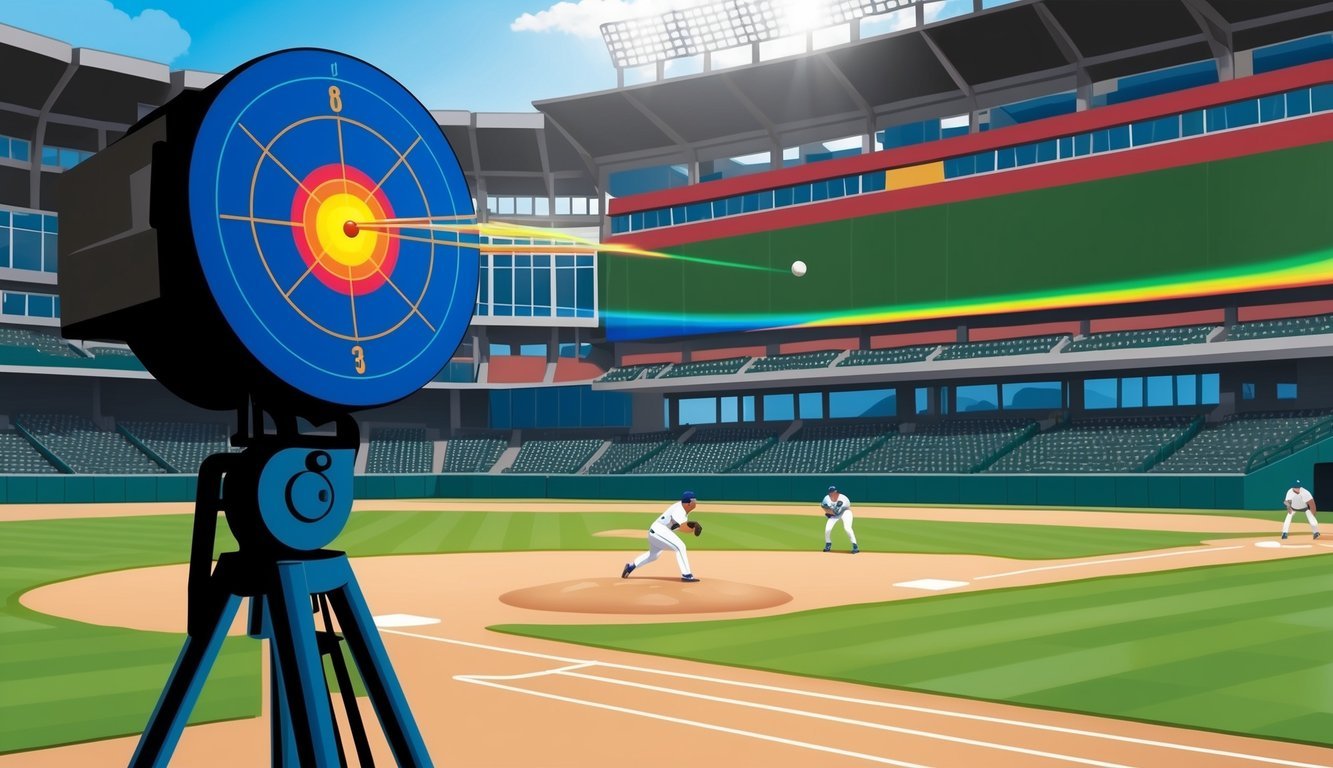Radar guns have become an essential tool in baseball, providing precise measurements of pitch speeds and helping players improve their game.
These handheld devices use Doppler radar technology to track the velocity of baseballs as they fly through the air.
The best baseball radar guns in 2024 can measure speeds from 25 to 130 MPH with accuracy within 1-2 MPH.
Players, coaches, and scouts rely on radar guns to evaluate pitching performance and potential.
From Little League to the Major Leagues, these devices offer valuable data for player development and recruitment.
Some models even connect to smartphones, allowing users to record and analyze speed data over time.
While traditional radar guns resemble bulky speed detectors, newer designs are more compact and user-friendly.
The Pocket Radar Smart Coach, for example, looks more like a small electronic device than a typical speed gun.
This evolution in design has made radar guns more accessible and convenient for baseball enthusiasts at all levels of the sport.
Understanding Radar Guns in Baseball
Radar guns have revolutionized how we measure and analyze pitching speeds in baseball.
These devices provide precise velocity readings, helping players, coaches, and fans gain valuable insights into a pitcher’s performance.
By quantifying speed and movement, radar guns assist pitchers in refining their techniques, including how to throw a slider, ensuring they can achieve optimal results on the mound.
Additionally, this data allows for more tailored training regimens, enabling players to develop their skills with a clear understanding of their progress.
History and Evolution
Radar guns first appeared in baseball during the 1970s.
Initially used by scouts to evaluate prospects, they quickly became an essential tool for teams and broadcasters.
Early models were bulky and required careful positioning to get accurate readings.
As technology advanced, radar guns became more compact and user-friendly.
By the 1980s, radar guns were common at major league ballparks.
They allowed fans to see pitch speeds on scoreboards, adding excitement to the game.
The 1990s saw further improvements in accuracy and portability.
Today’s radar guns are small enough to measure speeds from over 100 feet away.
Basic Principles of Radar Technology
Radar guns use the Doppler effect to measure ball speed.
They emit radio waves that bounce off the moving ball.
As the ball travels, it changes the frequency of the reflected waves.
The gun measures this change to calculate velocity.
Key components of a baseball radar gun include:
- Transmitter: Sends out radio waves
- Receiver: Detects reflected waves
- Processor: Calculates speed based on frequency changes
- Display: Shows the measured speed
Accuracy depends on factors like angle and distance.
For best results, the gun should be aimed directly at the ball’s path.
Most modern guns can measure speeds from 25 to over 150 mph with high precision.
Types of Radar Guns
Baseball radar guns come in several varieties:
-
Handheld guns: Popular with scouts and coaches. Easy to use but require steady hands.
-
Stationary guns: Mounted in fixed positions at ballparks. Provide consistent readings for every pitch.
-
Smartphone-connected devices: Small sensors that pair with mobile apps. Affordable and portable options for players and youth teams.
-
Professional-grade systems: High-end setups used by MLB teams. Often combine radar with video analysis for comprehensive data.
Each type has its strengths.
Handheld guns offer flexibility, while stationary units ensure consistency.
Smartphone options make the technology accessible to a wider audience.
Professional systems provide the most detailed information but at a higher cost.
Key Features of Baseball Radar Guns

Baseball radar guns come equipped with essential features designed to accurately measure pitch speeds.
These devices offer precise readings, user-friendly interfaces, and portable designs to meet the needs of coaches, scouts, and players.
Display and Ease of Use
Most baseball radar guns feature large LCD displays for easy reading of speed measurements.
Numbers are typically bold and clear, visible even in bright sunlight.
Many models offer one-button operation, allowing users to quickly capture speeds without fumbling with complex controls.
Some advanced units include memory functions to store multiple readings.
This feature lets coaches track a pitcher’s performance over time.
Wireless radar guns are gaining popularity, enabling remote monitoring and data transfer to smartphones or tablets.
Accuracy and Speed Range
Accuracy is crucial for baseball radar guns.
Top models boast precision within +/- 0.5 MPH, while budget options may have a margin of +/- 1 MPH.
The Jugs radar gun, for example, offers accuracy to within half a mile per hour.
Speed ranges vary by model.
Entry-level guns might measure 10-110 MPH, suitable for youth leagues.
Professional-grade devices can capture speeds from 5-140 MPH, covering everything from slow changeups to blazing fastballs.
Many radar guns allow users to switch between MPH and KPH, catering to international use.
Portability and Power Options
Baseball radar guns are designed for field use, emphasizing portability.
Most weigh less than a pound, making them easy to carry and operate with one hand.
Compact models like the Pocket Radar fit in a pocket or equipment bag.
Battery life is a key consideration.
Some guns use standard AA or AAA batteries, offering the convenience of quick replacement.
Others feature rechargeable lithium-ion batteries, providing longer usage times between charges.
Certain models include auto-shutoff features to conserve battery life when not in use.
This helps extend operating time during long practice sessions or scouting trips.
Selecting the Right Radar Gun
Choosing the perfect radar gun for baseball involves weighing several key factors.
The ideal device balances accuracy, features, and cost-effectiveness to meet specific needs on the field.
Considerations for Coaches and Scouts
Coaches and scouts require reliable tools to assess player performance.
The Stalker Sport 2 is popular among professionals for its precision and advanced features.
It offers accurate readings up to 300 feet away, making it ideal for scouting from the stands.
Look for guns with a wide speed range, typically 25-130 MPH, to capture everything from changeups to fastballs.
Some models provide additional data like spin rate, which can be crucial for player development.
Ease of use is essential.
Point-and-shoot designs allow quick readings during practice or games.
Models with memory functions let you store multiple readings for later analysis.
Price vs. Value
Radar guns range from $100 to $1,500+.
While budget-friendly options exist, investing in a higher-quality gun often pays off in the long run.
Entry-level models around $200 suit casual users or youth leagues.
Mid-range options ($300-$600) offer improved accuracy and durability, ideal for high school or college teams.
Professional-grade guns ($700+) provide the highest accuracy and advanced features.
These are best for serious scouts or elite programs where precision is paramount.
Consider how often you’ll use the gun.
Frequent use justifies a higher initial investment in a more robust, feature-rich model.
Warranty and Durability
Baseball fields can be tough on equipment.
Look for radar guns with sturdy construction to withstand accidental drops and weather exposure.
Many top brands offer 2-year warranties, providing peace of mind for your investment.
Some even include a 30-day money-back guarantee, allowing you to test the gun’s performance.
Water-resistant models are a smart choice for outdoor use.
Carry cases can provide extra protection during transport and storage.
Battery life is crucial for extended scouting sessions.
Opt for guns with long-lasting rechargeable batteries or those that use standard AA batteries for easy replacement.
Applying Radar Gun Technology in Practice

Radar guns have become essential tools for baseball teams, enhancing player development and evaluation.
These devices provide precise measurements of pitch speeds, helping teams refine their strategies and improve player performance.
Enhancing Pitcher Development
Radar guns play a crucial role in pitcher development.
Coaches use them to track pitch velocity over time, identifying areas for improvement.
Young pitchers can set velocity goals and monitor their progress.
The data helps trainers create personalized workout plans to boost arm strength and mechanics.
Radar guns also reveal velocity differences between pitch types.
This information allows pitchers to fine-tune their repertoire, ensuring adequate speed separation between fastballs and off-speed pitches.
Some advanced radar systems can measure spin rate and axis, providing even more detailed feedback for pitchers to refine their craft.
Improving Hitters’ Timing and Power
Hitters benefit from radar gun data too.
Knowing the exact speeds they face in practice helps batters adjust their timing and swing mechanics.
Coaches can simulate game-like conditions by mixing pitch speeds during batting practice.
Teams often use radar guns to measure exit velocity off the bat.
This data helps hitters optimize their swings for maximum power.
Players can experiment with different techniques and immediately see the impact on ball speed.
Radar readings also aid in developing a hitter’s pitch recognition skills.
By correlating pitch speeds with visual cues, batters can better anticipate and react to different pitches in game situations.
Statistical Analysis and Player Evaluation
Radar gun data feeds into broader statistical analysis for player evaluation.
Scouts use velocity readings to assess pitching prospects, while exit velocities help gauge a hitter’s potential.
Teams track pitch speed trends over a season to monitor pitcher fatigue or improvement.
This information guides decisions on rest, training, and game strategy.
For hitters, consistent improvements in exit velocity can indicate developing power, even before it translates to game performance.
This data helps teams identify breakout candidates and make informed roster decisions.
Radar gun stats also contribute to advanced metrics like “expected” outcomes, providing a more complete picture of a player’s true talent level.
Advanced Radar Gun Features in Baseball

Modern radar guns offer sophisticated capabilities beyond basic speed measurements.
These advanced features provide coaches and players with deeper insights into pitch dynamics and performance analysis.
Measuring Spin Rate and Ball Movement
Top-tier radar guns now track spin rate and ball movement, crucial metrics for pitchers.
The Pocket Radar Smart Coach stands out with its ability to capture these details.
It measures spin rates up to 3000 RPM, helping pitchers refine their breaking balls and off-speed pitches.
Some devices use high-speed cameras alongside radar technology to map pitch trajectories.
This combination allows for precise measurement of horizontal and vertical break.
Coaches use this data to help pitchers develop more effective curveballs, sliders, and changeups.
Advanced radar guns can also detect subtle variations in arm angles and release points.
This information is valuable for pitchers working on consistency and for batters studying opposing pitchers’ tendencies.
Integration with Mobile Devices
Cutting-edge radar guns now sync with smartphones and tablets.
The Pocket Radar Smart Coach connects to both iOS and Android devices via Bluetooth.
This integration enables real-time data analysis and storage.
Many apps paired with these devices offer video recording capabilities.
Players can review their pitches alongside speed and movement data.
Some systems even provide instant slow-motion replay, allowing for immediate technique adjustments.
Cloud storage features let teams build comprehensive databases of player performance over time.
Coaches can track progress, set goals, and identify areas for improvement based on long-term data trends.
These mobile integrations also facilitate remote coaching.
Players can share their stats and videos with coaches or scouts, even when practicing alone.
